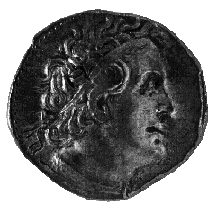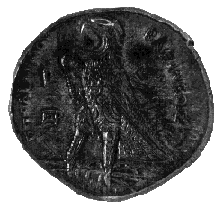



(54) Egypt, Ptolemy I Soter - AR tetradrachm, c. 305-283 B.C.,
14.31 g. (inv. 91.096).
Obverse: Diademed head of Ptolemy I r., with aegis; small ![]() behind ear.
behind ear.
Reverse: Eagle standing l. on thunderbolt, wings open; in l. field, ![]() above monogram;
above monogram;
![]()
![]() : of King Ptolemy.
: of King Ptolemy.
Provenance: Edward Gans, 1959.
Bibliography: O. Mørkholm, Early Hellenistic Coinage from the
Accession of Alexander to the Peace of Apamea (336-188 B.C.) (Cambridge
1991) 63-66.
After the death of Alexander the Great in 323 B.C., his general Ptolemy
claimed Alexander's land in Egypt. In 305/04 B.C. he assumed the title of
king, and the same year he was given the title Soter or Savior for saving
the people of Rhodes from Demetrios Poliorketes, king of Macedonia (see
no. 43). The Ptolemaic dynasty that he established controlled Egypt until
it was taken by Rome in 31 B.C.
Ptolemy's first coinage depicted a portrait of the deified Alexander on
the obverse, but with his increasing independence he became the first of
Alexander's successors to replace it with his own image. The portrait is
highly individualized, with deep-set eyes, high forehead, beaked nose, and
prominent chin, and yet the distant gaze, partially open mouth, and the
arrangement of the hair recall portraits of Alexander. He wears the royal
diadem and an aegis, an attribute of his patron deity, Zeus, around his
neck. This portrait type continued on the obverse of tetradrachms throughout
the Ptolemaic dynasty (see nos. 55, 59). This coin is dated to the reign
of Ptolemy I by the small ![]() , probably the engraver's initial, behind Ptolemy's
ear. The reverse depicts an eagle on a thunderbolt, both attributes of Zeus,
which Ptolemy adopted as his personal badge.
, probably the engraver's initial, behind Ptolemy's
ear. The reverse depicts an eagle on a thunderbolt, both attributes of Zeus,
which Ptolemy adopted as his personal badge.
K.J.B.



All contents copyright (c) 1996.
Lawrence University
All rights reserved.